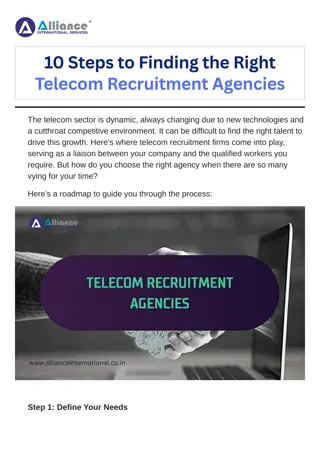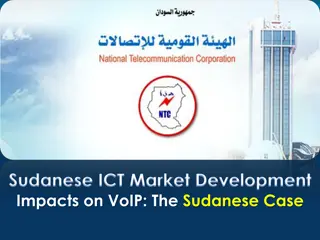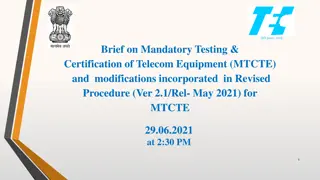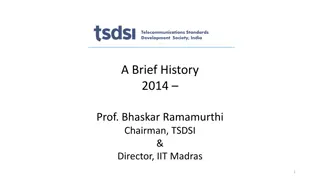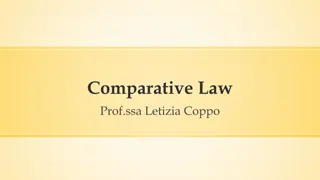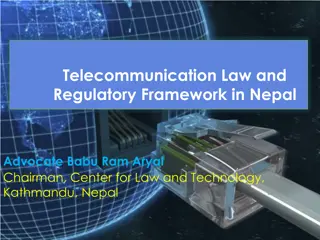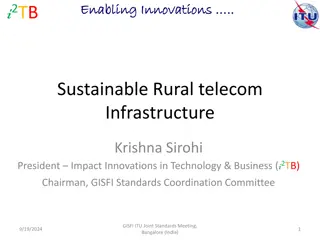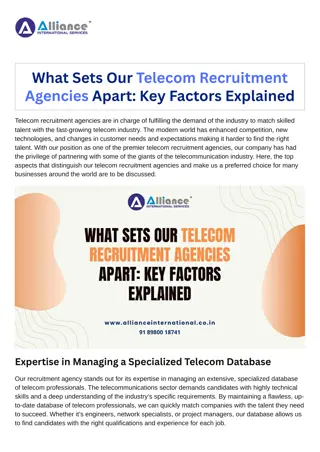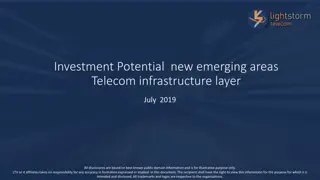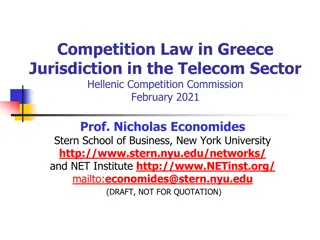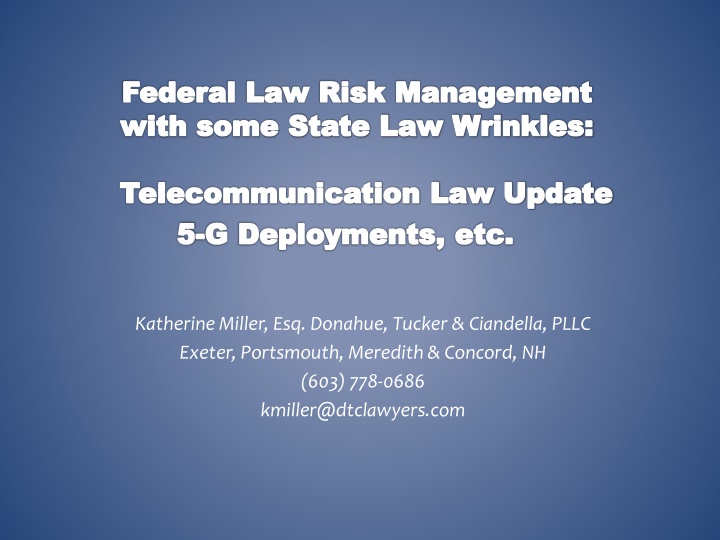
Telecommunication Law Update: Federal and State Considerations
Explore the complexities of federal and state telecommunication laws with a focus on 5G deployments, including key regulations like the 1996 Telecommunications Act and Section 6409. Learn about the conflict between state and federal laws, special protections for providing telecommunications services, and guidelines for municipal review of wireless communications facilities applications.
Download Presentation

Please find below an Image/Link to download the presentation.
The content on the website is provided AS IS for your information and personal use only. It may not be sold, licensed, or shared on other websites without obtaining consent from the author. If you encounter any issues during the download, it is possible that the publisher has removed the file from their server.
You are allowed to download the files provided on this website for personal or commercial use, subject to the condition that they are used lawfully. All files are the property of their respective owners.
The content on the website is provided AS IS for your information and personal use only. It may not be sold, licensed, or shared on other websites without obtaining consent from the author.
E N D
Presentation Transcript
Federal Law Risk Management with some State Law Wrinkles: Telecommunication Law Update 5-G Deployments, etc. Katherine Miller, Esq. Donahue, Tucker & Ciandella, PLLC Exeter, Portsmouth, Meredith & Concord, NH (603) 778-0686 kmiller@dtclawyers.com
APPLICABLE LAWS: 1996 Telecommunications Act (TCA), including Section 6409 Federal Communications Commission Regulations NH RSA 12-K: Deployment of Personal Wireless Facilities
CORE CONCEPTS State / Federal conflict: follow most restrictive law. Municipality cannot discriminate among providers of functionally equivalent [telecommunications] services. 47 USC 332 Can t effectively prohibit services. Id. Local decision must be made within reasonable time. Certain collocations, modifications and small cell deployments exempted from most local land use regulations and/or must be reviewed on short timeline.
TELECOMMUNICATIONS ACT SPECIAL PROTECTIONS 47 U.S.C Sec. 253: State and Municipal Laws or Regulations May Not Prohibit Any Entity From Providing Telecommunications Services Unless: Competitively Neutral, and Necessary, including for public health and safety
TELECOMMUNICATIONS ACT SPECIAL PROTECTIONS 47 U.S.C. Sec. 332 (c) (7) (B): Municipal Review of Personal Wireless Communications Facilities Applications: No discrimination among providers of functionally equivalent services Reasonable time frames for municipal board decision Denials must be in writing and based on substantial evidence in a written record Cannot prohibit or have the effective of prohibiting applicant from providing services Cannot deny application based on radio frequency emissions if they meet FCC standards
SECTION 6409 (47 U.S.C. 1455(A): Notwithstanding [the TCA] or any other provision of law, a State or local government may not deny, and shall approve, any eligible facilities* request for a modification of an existing wireless tower or base station that does not substantially change the physical dimensions of such tower or base station. *Eligible facilities request means (A) a collocation of new transmission equipment; (B) removal of transmissions equipment; or (C) replacement of transmission equipment.
FCC REPORT AND ORDER IMPLEMENTING 6409 FCC 14-153 (10/21/14): Covers any FCC-authorized wireless communications service, including personal wireless services ( cell phones ), broadcast facilities and public-safety communications. Differs from TCA 332(c)(7) which applies only to personal wireless facilities ( cell phones ) Transmission Equipment defined broadly to cover any equipment that facilitates any FCC-authorized wireless communications service Tower defined narrowly as a structure built solely or primarily to support FCC- licensed or authorized antennas and their equipment Base station defined broadly to include the equipment and the structure that houses or supports it, but only if the structure already supports or houses the equipment Short time for local government to act: 60 days, or application deemed granted. Time limit can be tolled by agreement or if applicant notified within 30 days of specific information missing from application
FCC REPORT AND ORDER FCC REPORT AND ORDER FCC 14 FCC 14- -153, CONTINUED 153, CONTINUED What modifications are permitted? Those that don t substantially change the physical dimensions of the wireless tower or base station, including: Height: not increased by more than 10% or the height of one additional antenna array, not to exceed 20 , whichever is greater Width: appurtenance cannot protrude more than 20 or the width of a tower at the height of the appurtenance, whichever is greater, or on another support structure, not more than 6 Equipment cabinets: for support structures, not to exceed 4 cabinets; for towers in the public right of way or base stations: on the ground: no more than 10% larger in height or volume than existing ground cabinets No excavations beyond site Won t defeat stealth sitings, such as concealed antennas. Or otherwise won t comply with existing conditions of approval.
FCC SECOND REPORT AND ORDER FCC SECOND REPORT AND ORDER ACCELERATING BROADBAND ACCELERATING BROADBAND DEPLOYMENT BY REMOVING DEPLOYMENT BY REMOVING BARRIERS TO INFRASTRUCTURE BARRIERS TO INFRASTRUCTURE INVESTMENT FCC 18 INVESTMENT FCC 18- -30 (PUBLISHED IN FEDERAL (PUBLISHED IN FEDERAL REGISTER 5/3/18) REGISTER 5/3/18) 30 Exempted applications not on tribal lands, and defined as small wireless facilities, for which no preconstruction authorization is required, 47 C.F.R. 1.1323, from review under National Historic Preservation Act ( NHPA) and National Environmental Policy Act ( NEPA ). Challenged in D.C. Court of Appeals and recently partially vacated and remanded to the FCC regarding the exemptions from review under NHPA and NEPA. United Keetoowah, Band of Cherokee Indians v. FCC (D.C. Cir.8/9/19) FCC Order DA-19-1024 (10/8/19) recently repealed those exemptions.
NEW HAMPSHIRE LAW SPECIAL PROTECTIONS NH RSA 12-K Exemption from zoning and planning for: Wireless facilities ( small cells ) and antennae attached to existing structures without a substantial modification, Only building/safety code review by code enforcement officer Short Deadlines 15 days to request more information 45 days to decide, or application deemed granted
THE NEXT WAVE: SMALL CELLS AND 5-G WIRELESS DEPLOYMENTS Expanding in Cities and towns; In public right-of-way and on private property How to plan for them, how to manage them when the applications come in?
MUNICIPAL AUTHORITY TO REGULATE PUBLIC RIGHTS OF WAY Cities and Towns have general authority to regulate public rights of way. In NH: Board of Selectmen: RSA 41:8, 41:11 City Council: RSA 44:2, 47:5, RSA 47:17 This authority specifically extends to regulating poles, conduit, and underground pipes. RSA 231:161 RSA 231:184
WIRELESS FACILITIES IN PUBLIC RIGHTS OF WAY In NH: RSA 231:159-189 addresses: Telegraph, telephone, television, and electric poles, structures, and underground conduit. Excavation in PROW for laying or repairing water and gas pipes. Wireless facilities not addressed.
MUNICIPAL AUTHORITY TO REGULATE WIRELESS FACILITIES IN PUBLIC RIGHTS OF WAY General municipal authority to regulate PROW Wireless carriers subject to municipal regulation. In NH - RSA 12-K:3, II-III. BUT collocations and some modifications are not subject to zoning and land use requirements or public hearing requirements (other than building permit requirements) under NH law (RSA Ch. 12-K) and Federal Law ( 6409) puts strict limits and timelines on review.
WHAT DO THOSE SMALL CELLS / 5-G DEPLOYMENTS LOOK LIKE IN THE PUBLIC RIGHTS OF WAY?
LESS INTRUSIVE SMALL WIRELESS FACILITIES
MORE INTRUSIVE SMALL WIRELESS FACILITIES
FCC THIRD REPORT AND ORDER ACCELERATING BROADBAND DEPLOYMENT BY REMOVING BARRIERS TO INFRASTRUCTURE INVESTMENT FCC 18-133 (PUBLISHED IN FEDERAL REGISTER 10/30/18) Wraps in prior rules on wireless facilities. Effective January 14, 2019 Order Discusses: Timelines: For decision on application for Small Wireless Facilities on existing structures: 60 days (cf. RSA 12-K: 45 days) For decision on collocation of a facility other than small cell: 90 days (cf. RSA 12-K: 45 days) For decision on small cell not on existing structure: 90 days For non-small cell: 150 days all inclusive (PB and ZBA?) Only fair and reasonable fees may be charged Approximately the municipality s costs for processing application, maintaining the PROW & structures in the PROW
MUNICIPALITY POTENTIAL PITFALLS Barring Wireless Facilities from PROW 47 U.S.C. Sec. 253 Categorical Ban of Wireless Facilities in community Include Wireless Facilities in an unmodified NH RSA 231 Process for Wired Pole and Conduit License Applications (remember the statute covers Telegraph poles?)
WHAT CAN MUNICIPALITIES DO? Comprehensive PROW Ordinance Model FCC Draft Code Comprehensive, All-Inclusive PROW Ordinance vs. Wireless Facilities-Only Ordinance for PROW Policies Must be Competitively Neutral and Necessary 47 U.S.C. Sec. 253
WHAT CAN MUNICIPALITIES DO? Implement Robust City Code re: PROW Access Ordinance adopted at Town Meeting Selectmen Ordinance re: PROW Access Well developed protocol or delegation of authority re: PROW Access
ELEMENTS OF PROW ORDINANCE 1. 2. Require attachment agreement with pole owner 3. Detailed procedure for timely review and decision on applications by municipality 4. Checklist for completed application 5. Clear definitions 6. Safety requirements 7. Aesthetic requirements 8. Costs for reviewing applications Require License for occupancy of PROW
LICENSE REQUIREMENT Best practice: require License from allusers of PROW Avoids discrimination between wireline telecommunications providers and wireless Include all attachers to poles/conduits (which also aids in PROW management and assessment of tax as required by law)
DETAILED PROCEDURE FOR HANDLING APPLICATIONS Promptly direct applications to trained employee Checklist for application completeness Detailed procedure for making decision within applicable deadlines. Separate procedure for collocations exempt from land use regulations.
COMPLY WITH FCC PROCEDURAL REQUIREMENTS Shot clock timelines Begin when application submitted Denials: In writing based on substantial evidence in written record
REVIEWING APPLICATIONS FOR COMPLETENESS One opportunity to review application for completeness. 10 days to notify applicant that small wireless facilities application is incomplete (cf. 15 days in RSA 12-K). 30 days for other applications (depending on facility, RSA 12-K may not grant 30 days). Tolls running of shot clock.
CLEAR DEFINITIONS Use statutory definitions. Where federal law and state law definitions are not identical, use more restrictive definition.
SAFETY CONCERNS Review by building inspector Collocations not exempt from building permit requirements When necessary review by engineer Radio Frequency Emissions Can require compliance with FCC requirements Can t have more restrictive regulations 47 USC 332 (c)(7)(B)(iv) Height Requirements No effective prohibition
AESTHETIC REQUIREMENTS Preempted unless Reasonable No more burdensome than those applied to other types of infrastructure deployments Objective and published in advance Avoid effective prohibition Waiver to extent necessary
APPLICATION FEES REQUIREMENTS Reasonable approximation of municipality s costs Factoring only objectively reasonable costs Not higher than charged to similarly situated competitors in similar situations Competitively neutral Is municipality charging telephone carriers for new pole applications?
APPLICATION FEES SAFE HARBOR FCC established fees that are presumptively reasonable: $500: collocation of 1-5 small wireless facilities, plus $100 for each additional small wireless facility $1,000 application for new pole intended to support small wireless facilities $270 recurring fee per small wireless facility per year
MODEL ORDINANCE FCC draft model ordinance More extensive than necessary for smaller communities
CONCLUSION To fulfill their duty to regulate public rights-of-way while minimizing the risk of litigation, Municipalities should: Ensure that all agreements for private use of PROW comply with RSA 72:23 Require PROW licenses and develop procedure for handling applications Develop detailed procedure for handling wireless facilities applications Train employees to properly process these applications.
QUESTIONS? THANK YOU FOR COMING!



